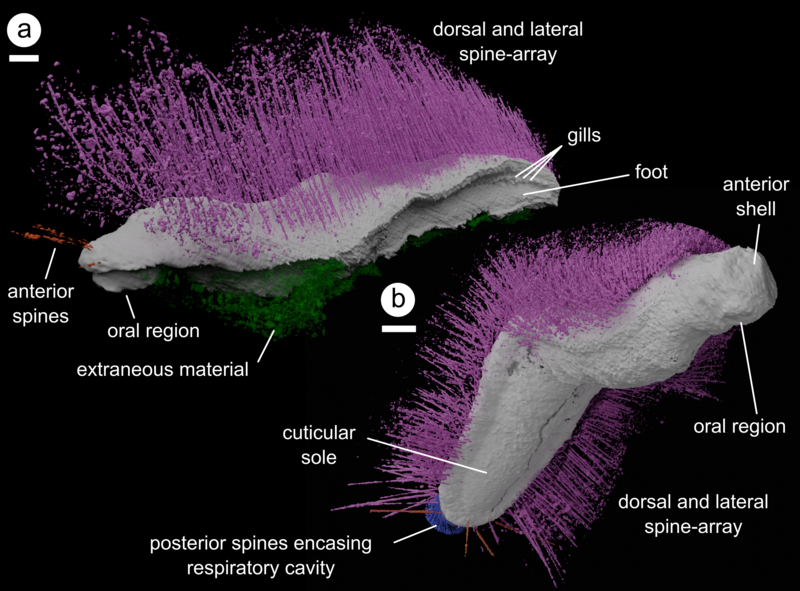A group of researchers, including Professor Derek Siveter of Oxford Earth Sciences and the Oxford University Museum of Natural History, have unearthed two fossils, named Punk and Emo, revealing that ancient molluscs were more complex and adaptable than previously known.
Molluscs are one of life’s most diverse animal groups and analysis of the rare 430 million year old fossils is challenging long-held views on their early origins. These new fossils dating from the Silurian period were retrieved from Herefordshire and shed light on the molluscs’ complex evolutionary history and how they moved. The discovery challenges the longstanding view that early molluscs from the group known as Aculifera – which include chitons and worm-like molluscs – were basic and primitive.
"These exceptionally preserved, unusual, 430 million year old fossils, which exhibit their soft-part morphology, offer rare insights into the early evolution of one of the major invertebrate groups, the molluscs, and indicate that the molluscan subgroup to which they belong (the Aculiferans) were more varied in ancient marine environments than in present ones."
- Professor Derek Siveter (study co-author), University of Oxford
Instead, the ‘rebellious’ fossils – whose scientific names are Punk ferox and Emo vorticaudum – show that early molluscs possessed some unique features and were, in fact, quite complex and adaptable in their forms and habitats. Researchers drew these conclusions by recreating the fossils in 3D using advanced imaging techniques, including X-ray scanning. They found that Emo and Punk displayed a wider variety of forms and movement strategies than researchers knew existed in this group of early molluscs.

Image showing a detailed 3D model of Punk (at the top) and Emo (at the bottom), reconstructed as digital virtual fossils. Both specimens from an undisclosed locality in Herefordshire, UK. Credit: Dr Mark Sutton, Imperial College London.
Fossils were exceptionally preserved
The study, published today in Nature, was led by Dr Mark Sutton, from the Department of Earth Science and Engineering at Imperial College London, working with Professor Derek Siveter and collaborators at the University of Leicester, the Senckenberg Research Institute and Natural History Museum Frankfurt, and Yale University. Dr Sutton said:
“Molluscs are one of the largest and most diverse animal groups on Earth. However, early Aculiferan molluscs are much less well-known than some of their relatives. We have limited information about this group, and for a very long time, we assumed they were rather basic, simple and primitive.
“Retrieving fossils that are so exceptionally well preserved and reveal details of the soft tissues is extremely rare. We have been able to create ‘virtual fossils’ – 3D digital models – providing us with a gold mine of information and helping us understand that the branch of molluscan evolution containing Emo and Punk was much more evolutionarily rich and diverse than we thought; as much as other mollusc groups.”
Unique features and unusual ways of moving
The team used two different methods to get a clear picture of the fossils both inside and out. First, they used X-ray scanning to get a detailed look at the internal structures without causing any external damage. They then carefully ground the fossils down in very thin layers, taking photos at each step to create a 3D image of the external features.
Researchers found both fossils had smooth undersides, suggesting that they lived on the sea floor, and they both possessed some unique features and unconventional movement strategies.
The Emo fossil is preserved in a folded posture, suggesting that it moved like an inchworm, using its spines to grip and push forward. Meanwhile, how Punk was able to move remains unclear to researchers, but they found it had a ridge-like foot, unlike any existing mollusc today.
“The names Punk and Emo were actually our initial pet names for these ancient molluscs, inspired by some of their unique features and individuality. Punk in particular, with its spiky appearance, clearly resembles a rebellious punk rocker – and we thought Emo complemented it well.”
Dr Mark Sutton (lead author), Imperial College London
While Punk resembles worm-like molluscs with long spines, it also has a broad foot and gills like chitons. Emo, similarly worm-like with a long body and spines, also features shells and a compressed body similar to chitons. This mix of features helps researchers better understand the mollusc evolutionary tree – pointing to a story that involves more complexity and diversity than previously thought.
The study "New Silurian aculiferan fossils reveal complex early history of Mollusca" is available to read in Nature at https://doi.org/10.1038/s41586-024-08312-0.